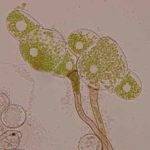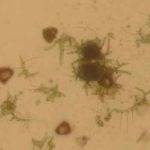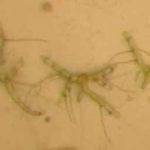Noeleen Smyth (National Botanic Gardens), Sinead Phelan & Gerry Douglas (Teagasc Research Institute, Malahide Road, Kinsealy, Co. Dublin)

Trichomanes speciosum, Killarney Fern Trichomanes speciosum Willd (Killarney fern) is a large filmy fern in the family Hymenophyllaceae. T. speciosum has a typical fern 2-stage life cycle, the second “fern” like stage is known as the sporophyte and the first stage the gametophyte, which is in this case, consists of a filamentous structure instead of a prothallis. Gametophyte colonies can exist and reproduce in the absence of sporophytes (Rumsey et al. 1998a). Sporophyte colonies are more limited in their distribution in Ireland than gametophyte colonies. Both the sporophyte and gametophyte stages are capable of asexual reproduction by mean of rhizomes (in the former) and gemmae (in the latter) (Vogel et al. 1993).
In Ireland when the sporophyte and gametophyte occur together they occupy similar habitats, in dripping caves, cliffs, crevices, waterfall gullies, crevices in woodland, and occasionally on the floor of damp woodland, all these habitats are deeply shaded and humid (Ratcliffe et. al 1993; Johnson et al. 2000; Kingston & Hayes 2005). Gametophyte colonies have been found in less humid habitats and have also been found with differing associated species (Kingston & Hayes 2005). Gametophyte colonies can also exist and reproduce in the absence of sporophytes (Rumsey et al. 1998). Sporophyte colonies are more limited in their distribution in Ireland than gametophyte colonies.
Killarney fern in Ireland
The first known record of Trichomanes speciosum in Ireland was made by Dr. Whitley Stokes at Powerscourt Waterfall around the 1800’s (Colgan & Scully 1898). The gametophyte was discovered growing in Ireland as recently as the 1990’s and several new gametophyte locations have been discovered since (Rumsey et al. 1998a; NPWS unpublished records). The range of Trichomanes speciosum in Ireland is centred on the extreme south in Kerry and West Cork. There are restricted sites in Carlow, Clare, Donegal, Limerick, Waterford, Wicklow and Sligo (Curtis & McGough 1998 & NPWS unpublished data). The gametophyte range is similar but is more widespread and occurs in counties Galway and Mayo (Rumsey et al. 1998 & Preston et al. 2002). The population of Trichomanes speciosum in Ireland is of extreme importance in a European context. One of the sites where it occurs is considered one of the largest in Europe and appears to be fairly stable. Certainly it was more widespread in the past and was collected extensively during the Victorian fern craze (Allen 1969), and while the number of populations may have not significantly fallen it may be that the number of plants in each population has decreased.
Legal protection for the Killarney fern in Ireland
Some of the rarest plants in Ireland, including Trichomanes speciosum, are protected under the Flora Protection Order (1999). It is an offence to cut, uproot or damage plants included in this list. The Habitats Directive, which specifically protects Trichomanes speciosum in Annex IIb is transposed into Irish law in the European Communities (Natural Habitats) Regulations (S.I. 94 of 1997). The Habitats Directive provides protection for the habitats of listed plants as well as the plants themselves. Under Annex IIb, each member state must designate Special Areas of Conservation for Trichomanes speciosum. Ireland to date has 39 special areas of conservation (SAC’s) in which Trichomanes speciosum is one of the key features.
Killarney fern at the National Botanic Gardens
Killarney fern has been cultivated at the national botanic Gardens Glasnevin for over 150 years. The most recent and surviving accessions date from the 1970’s. The Glasshouse foreman Mr. Brendan Sayers and section horticulturist Mr. Stephen Farrely noted the appearance of fertile fronds on these cultivated plants. The fertile fronds of T. speciosum were then harvested for ripe capsules in October 2007. Ripe sporangia were removed from individual capsules and washed five times in distilled water and allowed to dry on a sterile petri dish. The sporangial contents of each capsule were then transferred under aseptic conditions in a laminar flow bench to individual petri dishes, and allowed to dehisce for half an hour under lights. No further sterilisation procedures for the spores were undertaken as it was felt they would be sterile, having freshly emerged from the sporangium under aseptic conditions, and sterilisation would prove too harsh for the chlorophyllous spores. Three different media mixes were prepared (see Table 1) and poured onto petri dish plates and allowed to set. The spores were collected with a bevelled syringe needle (Sigma Aldrich, Syringe needle SS 23Gx1 regular bevel) with four spore collections smeared in four patches per plate. Spores were sown and cultured on three different inorganic nutrient media solidified with 1% agar (see Table 1.). The cultures were grown under fluorescent illumination with 16 hours light and 8 hours darkness at 20 (± 2) °C.
| Table 1 Spore germination and rhizome culture media mixes | |||
| Media Mixes | Details | Location | Number |
| Parker (Klekowski 1969) modified pH 5.8 |
4 spore clumps per petri dish |
Culture room Kinsealy | 13 petri dishes |
| Parker (Klekowski 1969) modified pH 7.0 |
4 spore clumps per petri dish |
Culture room Kinsealy | 12 petri dishes |
| Knops (Murashige & Skoog 1962) |
4 spore clumps per petri dish |
Culture room Kinsealy | 10 petri dishes |
Results
The more acidic Parker medium (pH5.8) as detailed by Klekowski (1969) proved to be the most suitable media mix for germinating Killarney fern spores with 42% germination success and over seventy percent of the plates used with Parker pH 5.8 media had germinated clumps. The nutrient rich Knops media, which is widely used for the in vitro culture of many species, was not suitable for Killarney fern spore germination. To date the lack of a suitable sterilisation technique for the sensitive spores has been a drawback, the majority of plates infected with fungi and algae however, a special filter has been purchased at kinsealy which will enable us to surface sterilise the spores after the dehisce from the sporangium and before sowing. Despite the infection the germinated spores have been growing well with growth extension ranging from three to seven cells from November 2007 to January 2008 (see plates 1 and 2 below).
| Media Mixes | Details | Plates | No. of germinating clumps | No. of plates with germinating spores |
| Parker (Klekowski 1969) modified pH 5.8 | 4 spore clumps per petri dish | 13 petri dishes | 22 (42.30%) | 10 (76.92%) |
| Parker (Klekowski 1969) modified pH 7.0 | 4 spore clumps per petri dish | 12 petri dishes | 4 (8.33%) | 3 (25.00%) |
| Knops (Murashige & Skoog 1962) | 4 spore clumps per petri dish | 10 petri dishes | 0 | 0 |
- Plate 1 Germinated Killarney fern spores sown on the 11th October and pictured here on the 15th November, Photo by Gerry Douglas
- Plate 2 Germinated Killarney fern spores growing into the distinctive gametophytic stage at three months pictured on the 7th of January 2008, Photo by Gerry Douglas
- Plate 2 The same pictured on the 17th of January 2008, Photo by Gerry Douglas
References
Allen, D.E. 1969. The Victorian Fern Craze. Hutchinson, London.
Colgan, N. & Scully, R.W. 1898. Contributions towards a Cybele Hibernica. 2nd Ed. Edward Ponsonby, Dublin.
Curtis, T.G.F. and McGough, H.N. (1988). The Irish Red Data Book: 1. Vascular Plants. Wildlife Service Ireland.
Johnson, G.N., Rumsey, F.J., Headley, A.D. & Sheffield, E. 2000. Adaptations to extreme low light in the fern Trichomanes speciosum. New Phytologist 148:423-431.
Kingston, N. & Hayes, C. 2005. The ecology and conservation of the gametophyte generation of the Killarney Fern (Trichomanes speciosum Willd.) in Ireland. Biology and Environment: Proceedings of the Royal Irish Academy 105B (2):71-79.
Klekowski, E.J. 1969. Reproductive biology of the pteridophyta. III. A study of the Blechnaceae. Botanical Journal of the Linnaean Society 62:361-377.
Murashige T and Skoog F (1962. A revised medium for rapid growth and bioassays with tobacco tissue cultures. Physiol. Plant 15(3): 473-497.
NPWS (2007). All Ireland Species Action Plan–Killarney Fern. Draft for public consultation. National Parks and Wildlife Service and Environment and Heritage Service, Northern Ireland.
Preston, C.D., Pearman, D.A. & Dines, T.D. 2002. New Atlas of the British & Irish Flora. Oxford University Press, Oxford.
Ratcliffe, D.A., Birks, H.J.B., & Birks, H.H. 1993. The ecology and conservation of the Killarney Fern Trichomanes speciosum Willd. in Britain and Ireland. Biological Conservation 66:231-247.
Rumsey, F.J., Jermy, A.C., & Sheffield, E., 1998. The independent gametophytic stage of Trichomanes speciosum Willd. (Hymenophyllaceae), the Killarney Fern and its distribution in the British Isles . Watsonia 22:1-19.
Vogel, J.C., Jessen, S., Gibby, M., Jermy, A.C. & Ellis, L. 1993. Gametophytes of Trichomanes speciosum (Hymenophyllaceae: Pteridophyta) in Central Europe. Fern Gazette 14:227-232.



